Publication
auri Research Brief
Current Status and Issues Regarding Public Spaces for Pets in South Korea
- No.87
- 2023.12.22
- Hit 13237
- Yoo, Yeseul Assistant Research Fellow
- Son, Eunshin Associate Research Fellow
With the recent changes in family compositions - such as the increase in DINK (dual income, no kids) and single-person households - and a cultural shift of recognizing animals as family members, there has been a rapid increase in the supply and demand for pet-friendly public spaces.
An analysis of the current status and issues of 123 public spaces for pets in the country as of August of 2023 reveals a steady increase in the number of facilities, with the proportion of large-scale spaces also increasing. However, the number of available spaces is still insufficient compared to the number of pet-owning households. Due to legal issues and concerns about complaints, such facilities are often located in places with low accessibility, such as the outskirts of cities, and more than half of such places are small-scale or temporary facilities. In addition, due to the nature of pet-related work, which involves handling many complaints, it is difficult to cooperate with local government departments and to establish an operating entity.
To address these issues, there must be a solid foundation for a system to create public spaces for pets. First, a ‘construction manual’ that includes appropriate locations, scales, and more must be prepared along with a ‘design guideline’ that includes space compositions, facilities, materials, and other pertinent information. In addition, there must be increased participation of experts from various relevant fields. In the long term, neighborhood environments where conflicts often occur must be improved by updating features such as street environments, landscaping spaces in apartment complexes, and more.
How many people in Korea have pets? According to data from Statistics Korea (2020), households raising pets amount to 15% of the total number of households.1) The demand for pet-friendly spaces has been skyrocketing in recent years, especially as the typical family composition has changed with the rise of DINKs and single-person households, along with a culture that recognizes animals as part of the family. Relevant industries in the private sector, such as dog cafes and hotels, are expanding. Furthermore, pet parks - where pets can walk and exercise off-leash - are on the rise.
Considering these changes in social conditions and the demands of pet owners, local governments have recently been expanding the installation of related public spaces such as dog playgrounds, pet parks, and theme parks. However, difficulties arise from the initial site-selection process, including legal restrictions and concerns about resident complaints. In some cases, it may be challenging to choose appropriate locations or secure adequately sized spaces. As a result, there are instances where it becomes difficult to ensure the quality of the facilities, resulting in temporary structures.
Through this study, we aim to analyze the current status of pet-related public spaces in Korea and discover relevant policy issues. We analyzed the current state of public spaces for pets, including pet playgrounds and pet parks, in Korea by examining the characteristics of their locations, spatial features, and types to extract key policy issues and to propose new policies.
Current Legal Status of Regarding Public Spaces for Pets in Korea
- “Animal Protection Act”
According to the “Animal Protection Act,” pets refer to animals such as dogs and cats as defined by the Ministry of Agriculture, Food and Rural Affairs, while the “Enforcement Rule of the Animal Protection Act” refers to dogs, cats, rabbits, ferrets, guinea pigs, and hamsters.2) In particular, the “Animal Protection Act” has a “Registered Animal” system for the “protection of animals, prevention of loss and abandonment, management of diseases, and prevention of public health hazards.” According to the enforcement rule, registered animals are defined as “dogs aged two months or older” that are raised in residences or for companion purposes. Therefore, under the current law, animals subject to registration can be considered companion dogs.3) Currently, as most pet-friendly public spaces are restricted to registered animals, in effect, most pet-friendly public spaces target dogs.
- “Act on Urban Parks and Green Spaces”
‘Animal playgrounds’ can be built in neighborhood parks sized 100,000㎡ or larger as well as cultural parks and sports parks of a metropolitan city with a population of 500,000 or more, in accordance with Articles 9 to 11 of the “Enforcement Rules for the Act on Urban Parks and Green Spaces” and Article 15 of the “Act on Urban Parks and Green Spaces.” Accordingly, Gwangju Metropolitan City, Osan City, Siheung City, and Hanam City have enacted and are operating relevant ordinances.
Although “pet parks” are not classified as a specific type of park according to the law, some local ordinances specify and operate them as specialized types under Article 15, Paragraph 1, Item 3 of “Act on Urban Parks and Green Spaces.” Currently, five metropolitan cities - Gwangju, Daejeon, Daegu, Ulsan, and Incheon - and five cities - Goyang, Gimhae, Bucheon, Siheung, and Jeonju - have established and operated pet parks under the “Act on Urban Parks and Green Spaces.”
- Other laws and local ordinances
Recently, there has been an increase in the number of amendments to laws and local government ordinances that allow the establishment of pet-related facilities and public spaces. An example is the amendment to the “River Act” that came into effect on July 4. Originally, livestock grazing or breeding was prohibited in river areas, but the revised “River Act” that passed last January 3 allows the installation of exercise and rest facilities for animals subject to registration under the “Animal Protection Act.”4) As a result, it is now possible to install facilities such as animal playgrounds for pets along riverbanks. Some local governments, including Seoul and Guri City in Gyeonggi Province, have revealed plans to develop pet playgrounds along riverbanks.
Additionally, as of 2023, 91 metropolitan cities and counties nationwide have established and are operating ordinances related to pets based on laws such as the “Animal Protection Act.” Among these, there are ordinances that support the creation and expansion of cultural spaces related to the protection and welfare of pets, including public spaces,5) as well as ordinances specifically addressing the establishment and operation of facilities such as pet parks, cultural centers, playgrounds, theme parks, and animal shelters.6)
Current status of public spaces for pets in Korea
As of August 21, 2023, a total of 123 public spaces for pets, including animal playgrounds and pet parks based on the “Act on Urban Parks and Green Spaces,” have been established or are in the process of planning and development.7) Such types of public spaces for pets are areas specifically designed for off-leash activities and are specialized spaces for pets.
- Serves an average of 25,439 households per location
By region, Gyeonggi Province has the most pet-related public spaces in Korea, with a total of 39, followed by Seoul (22), Gyeongsangnam-do (8), and Gangwon-do (7). However, as the number of households with pets in Korea exceeded 3 million as of 2020 (3,128,962 households),8) regardless of regional comparisons, there is a severe shortage of public spaces for pets. Even if we only calculate the number of households per public space, this number works out to be 25,439 nationwide.
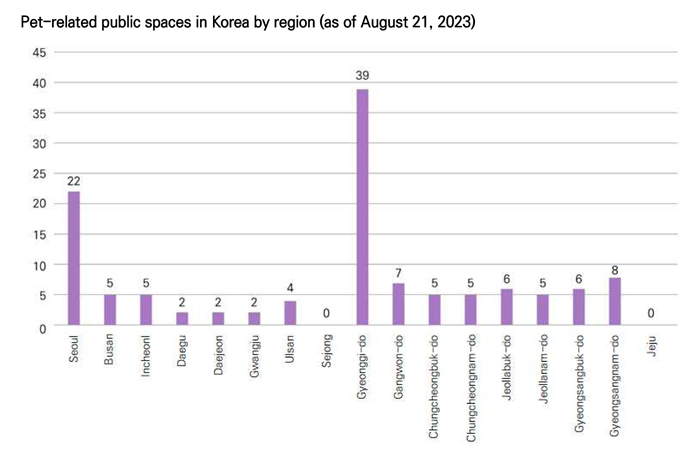
- Creation of new public spaces in double digits since 2018 with an increasing proportion of large scale spaces
The number of public spaces for pets has steadily increased since 2012, and since 2018, new public spaces have been created in the double digits every year. Starting with the nation’s first off-leash park, ‘Dog Exercise Park’ in Nam-gu, Ulsan in 2012, public spaces for pets were initially created mainly in metropolitan areas and large cities. Public spaces for pets began to be created in regional cities as well with the creation of ‘Osu Dog Playground’ in Imsil-gun, Jeollabuk-do in 2014.
In addition to the increase in new spaces, there has been an increase in the number of public spaces that are larger than a certain size (2,000㎡ or 1/2 acre). To date, 37 public spaces for pets that are 2,000㎡ or larger have been created, accounting for 32.7% of the total number of spaces. Thirty-three of these spaces have been created since 2018. In particular, the number of large-scale, pet-specific parks exceeding an area of 10,000㎡ has increased since 2020, with seven spaces having been created or in the works.
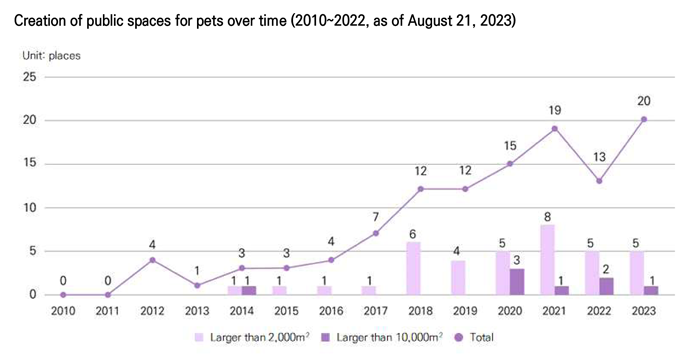
Sizes of Public Spaces for Pets in Korea
- International guidelines recommend securing at least 500㎡
What is the appropriate size of public spaces for pets? Looking at overseas guidelines, the Tokyo Minato Ward Improvement Plan (2011) recommends at least 500㎡ or more, and generally 1,000㎡ or more (Minato Ward, Tokyo, Japan, 2011, p.13). According to the guidelines of Ann Arbor, Michigan (2013), approximately 2,000㎡ or more is considered sufficient (City of Ann Arbor, 2013, p.8), while according to the American Kennel Club (AKC), the largest dog association in the United States, 4,000㎡ or more is considered to be sufficient for a dog park.9) Although the standards differ by country, it can be seen that at least 500㎡ or more must be secured.
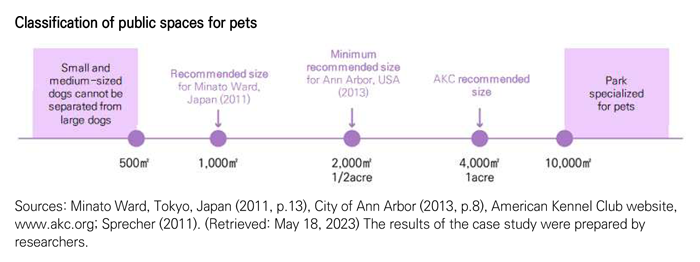
- Domestic public spaces for pets can be classified as very small (under 500㎡), small (500~2,000㎡), medium (2,000~10,000㎡), and large (over 10,000㎡)
After surveying public spaces for pets, it was determined that it is difficult to segregate small and medium-sized dogs from large dogs in spaces under 500㎡. A total of seven large-scale spaces of 10,000㎡ or larger have been created in Korea, with all of them believed to be large-scale parks specializing in pets.10) The classification of spaces is consolidated based on a review of international guidelines and on-site survey results. Spaces below 500㎡ are categorized as very small-scale, 500~2,000㎡ as small-scale, 2,000~10,000㎡ as medium-scale, and 10,000㎡ and over as large-scale.
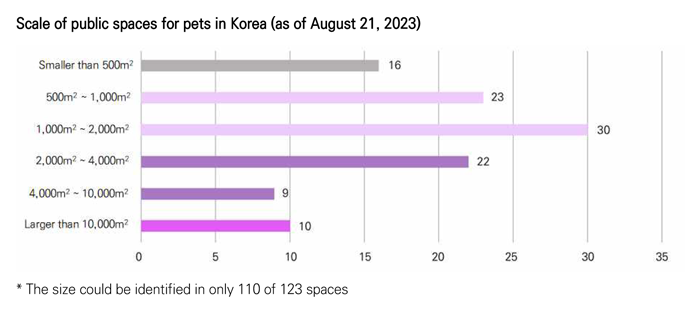
Spaces larger than 10,000㎡ are classified as “Pet Specialized Parks,” while spaces smaller than 10,000㎡ are mostly designated as “Animal Playgrounds.”
There are 16 very small spaces (500㎡ or smaller), accounting for approximately 13% of the total, and these are often temporary installations. These spaces are often quite small and only serve small and medium-sized dogs, or they have separate hours for small, medium-sized, and large dogs. In the small-scale category, there are 23 spaces that are 500~1,000㎡ and 30 spaces that are 1,000~2,000㎡, totaling 53 spaces or 43.1% of the total. Most of these very small and small-scale spaces are animal playgrounds that have fences and safety gates within the park.
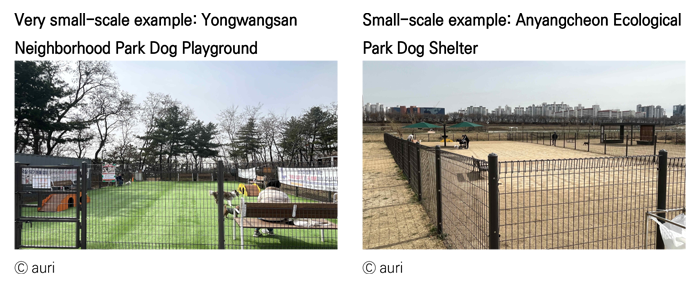
There are a total of 31 medium-sized spaces, including 22 spaces that are 2,000~4,000㎡ and nine spaces 4,000~10,000㎡. Medium-sized spaces exceeding 4,000㎡, which is the size recommended by the AKC, consist of a mix of animal playgrounds and pet parks.11) Large spaces over 10,000㎡ account for 8.1% of the total, and all of them are pet parks.
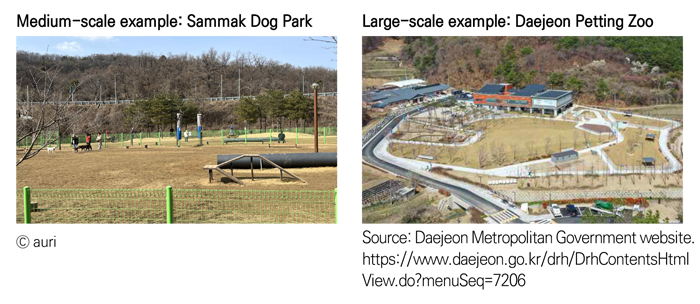
Location of public spaces for pets in Korea
- The majority of spaces tend to be in green zones
Where should public spaces for pets be located? By examining the distribution of land use zones according to the National Land Planning and Utilization Act, 81 out of 123 (approximately 65.9%) are situated in green zones. This primarily stems from the fact that the establishment of public spaces related to pets (animal playgrounds and pet parks) is mainly based on the “Act on Urban Parks and Green Spaces.” There are 11 spaces in residential areas, three in commercial areas, and four in industrial areas. However, the creation of public spaces for pets is considerably limited in residential, commercial, and industrial areas outside of green spaces, where parks are predominantly located.
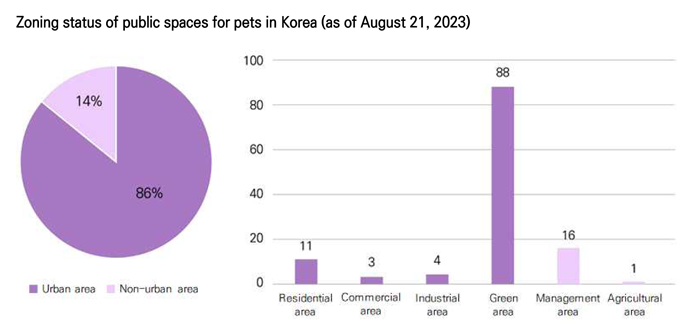
- Increased installation in development-restricted areas, river areas, and similar areas
Meanwhile, what is noteworthy among the zones according to the “National Land Planning and Utilization Act” is that eleven spaces in total have been installed or are in the process of being installed in development-restriction zones.12) However, parks, green spaces, outdoor sports facilities, and more may be created with permission from the head of the local government in accordance with Article 12 of the Act on Special Measures for the Designation and Management of Development-Restriction Zones.
Furthermore, eleven locations have been developed in river zones under the “River Act.” Initially, the “River Act” prohibited the establishment of spaces for pets in river zones; therefore, among the eleven public spaces installed to date, eight are temporary and three are established through urban planning facilities such as parks and cultural centers. However, with the recent amendment to the “River Act” allowing the installation of facilities for the exercise and relaxation of pets within river zones, there are emerging changes, such as the conversion of temporary facilities into permanent spaces and the pilot operation of public spaces for pets within river zones.
- Among urban planning facilities, public spaces for pets are most often installed in parks and tend to be created in conjunction with unwanted facilities
There are a significant number of public spaces for pets installed within parks (55 out of 123 spaces) due to the “Act on Urban Parks and Green Spaces.” However, due to complaints during the site-selection process, these spaces are occasionally integrated with transportation facilities, public and cultural sports facilities, environmental infrastructure, flood control facilities, and others, even if they are located far from residential areas. In addition, among the public spaces for pets created in conjunction with parks, there are examples of installations in parks located in sewage treatment plants, waste treatment plants, old crematoria, and industrial complexes. In particular, cases where unused land such as roads,13) railways, public parks, amusement parks, schools, sports fields, and public buildings are utilized are often located away from residential areas to prevent complaints from residents in the surrounding area.
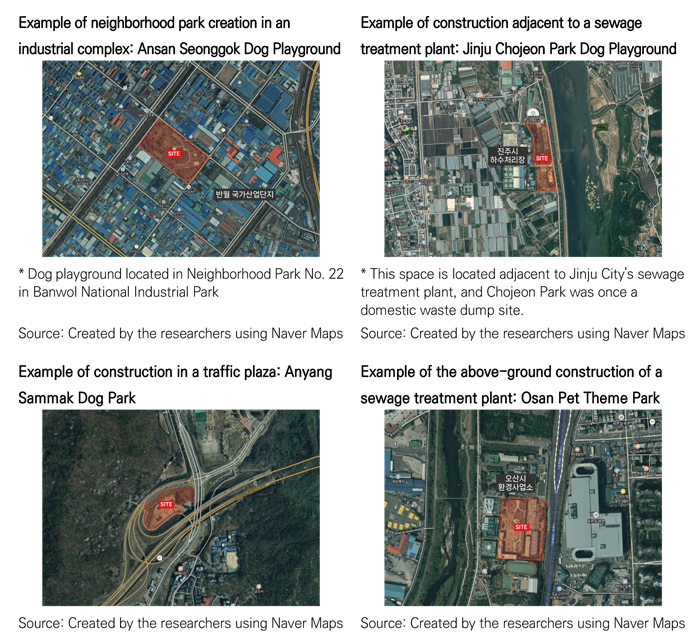
- More public spaces are being built in conjunction with other public spaces.
Due to the aforementioned location issues, there are also cases where public spaces for pets have been secured in conjunction with public facilities for other purposes. Depending on which department is in charge of pet-related affairs, these are often combined with public facilities such as animal protection centers, agricultural technology centers, and local food stores.
Meanwhile, in consideration of the rapidly increasing demand for tourism with pets, there are cases in which public spaces for pets are installed in connection with tourist attractions. By creating off-leash spaces such as animal playgrounds at major tourist facilities and recreation facilities, the number of infrastructure expansions for visitors who want to travel with their pets is gradually increasing.
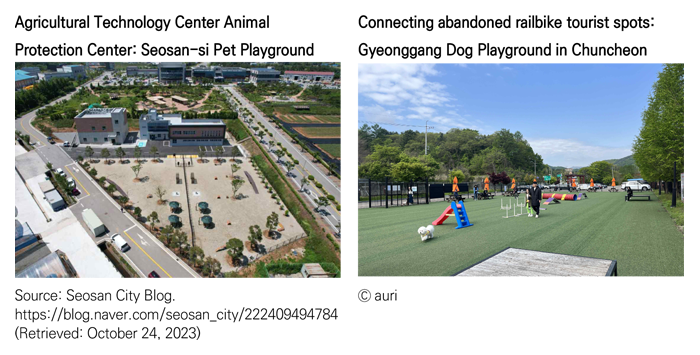
Types of public spaces for pets in Korea
To date, public spaces for pets in South Korea can be categorized into two types: pet playgrounds created within designated areas in existing parks and pet parks established as dedicated spaces exclusively for pets. Both types of spaces are off-leash areas designed for registered animals, primarily focusing on dogs, which are subject to registration under the “Animal Protection Act” and spend a significant amount of time outdoors.
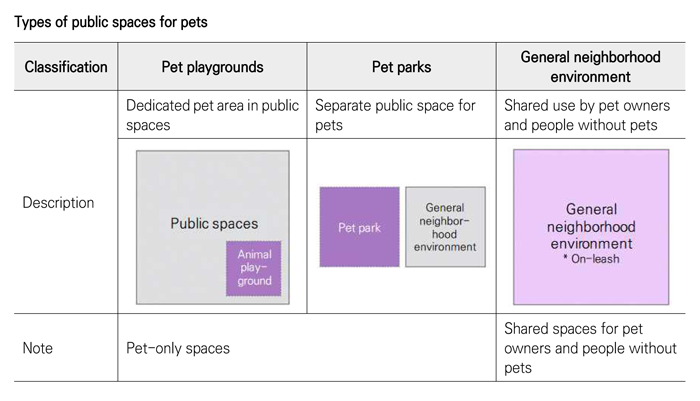
A pet playground is a type of public space for pets that involves the establishment of an isolation area for pets within existing public spaces, such as parks. Legally, these are designated as an animal playground under the “Act on Urban Parks and Green Spaces” and are commonly referred to as a dog playground or other similar terms. Pet playgrounds are most frequently established in spaces ranging from very small to small to medium-sized (less than 4,000㎡). Because these playgrounds occupy a portion of existing public spaces such as parks, they require cooperation from the department responsible for existing public spaces. There is also a potential for complaints from local residents who use existing public spaces. Due to these challenges, some local governments install temporary dog playgrounds then initiate a feedback process between stakeholders and local residents before installing permanent spaces.14)
Pet parks, on the other hand, are primarily composed of medium-sized (over 4,000㎡) and large-sized spaces (10,000㎡). Recently, there is a growing trend towards the development of large spaces for walking pets, exercising, engaging in leisure activities, and more, intended for both pets and their owners. Pet parks are specialized spaces often featuring various animal protection facilities, convenient amenities, and tourism-related facilities. However, due to their substantial size, conflicts among residents often arise during the site-selection process. Thus, these parks are often located far from residential areas, i.e., near sewage treatment plants, along roads with poor accessibility, or in restricted development zones on the outskirts of the city.15)
Finally, in general neighborhood environments where most pet outdoor activities such as exercise and walking take place, the public spaces can be used by anyone as long as the pets are kept on leashes within 2m, according to the “Animal Protection Act.” Recently, various neighborhoods with green spaces where dogs can walk without the risk of injury and trails with dog playgrounds nearby have been recommended as walking trails by local governments to revitalize tourism.16)
Public issues and policies regarding public spaces for pets in Korea
According to an analysis of 123 public spaces for pets in Korea, the number of public spaces for pets is steadily increasing and the proportion of large spaces is also increasing. However, the number of available spaces relative to the number of pet-owning households is still insufficient. One of the most pressing problems with regard to creating more spaces is their locations, as they are often located in inaccessible areas such as the outskirts of cities and abandoned facilities due to legal issues and concerns about local residents' complaints, and small or temporary facilities account for more than half of such spaces. Due to the nature of their work, which involves handling a large number of complaints, it is also difficult to coordinate with local government departments. These issues are related to quality issues such as accessibility, and to deal with them it is necessary to respond to the growing demand for pet-related spaces by establishing a system for creating public spaces for pets.
- Create a manual for creating public spaces for pets.
First, a manual must be prepared for space creation. Currently, there is no manual pertaining to the creation and management of public spaces for pets, including appropriate locations and scales, facility standards, and management and operation plans. The number of public spaces for pets is increasing in response to the rapidly growing demand. It is necessary to establish a proper basis for the size, location selection, and management and operation standards through a space creation work manual and to present a clear basis for determining the locations and sizes of public spaces for pets.
- Create design guidelines regarding public spaces for pets.
Second, it is essential to improve the quality of space creation and utilization by specifying the important aspects of the process, such as the space composition, facility selection, material selection, and others through the establishment of design guidelines. Animal protection centers, which protect lost or abandoned animals, manage minimum facility standards by distributing facility design guidelines to local governments, as specified in the guidance provided by the Ministry of Agriculture, Food and Rural Affairs in 2022 (Ministry of Agriculture, Food and Rural Affairs, 2022). Similarly, it is necessary to establish basic design guidelines to ensure minimum facility standards regarding public spaces for pets. While Gyeonggi Province and Seoul have established standards for installing dog playgrounds, these are primarily intended to support construction expenses. Pet park guidelines from other countries such as Australia, Japan, and Canada can be studied to establish comprehensive design guidelines regarding public spaces for pets in South Korea.
- Engage with wider range of subject-matter experts.
In addition, it is important to engage and discuss these issues with experts in various related fields when preparing the work manual and design guidelines. Currently, when local governments take the initiative to create public spaces for pets, they do not have basic manuals or guidelines. Instead, they rely on interviews with representatives of other local governments that have already created and operated such spaces. Some local governments have established task forces consisting of experts in related fields to discuss space organization, facility selection, and material selection, but this is limited to local governments that can afford to do so. Because public spaces for pets are for both humans and animals, they must be created and operated with the participation of animal-related experts in animal behavior and veterinary medicine as well as experts in relevant fields such as landscape design and urban planning.
- In the long term, it is necessary to consider pets throughout the neighborhood environment.
Finally, despite the increasing development of public spaces for pets, there is still a shortage of supply. Considering the general local environment is crucial, especially in areas where pet owners and people out pets share space, such as streets and apartment complexes. The overall neighborhood environment must be considered by starting with the introduction of small-scale facilities related to pets through collaborations with experts such as animal behavior experts and facility designers.
Along with the expansion in the number of spaces to handle the ever-increasing number of pet owners and related demands, there must be a creation system to improve the quality of spaces. This will be an important first step to resolve conflicts that may arise in public spaces shared by pet owners and those without pets as well as to view pets as social actors in the city, which is in line with the international trend toward inclusive cities.
1) Statistics Korea (2022). https://kosis.kr/statHtml/statHtml.do?orgId=101&tblId=DT_1PH2012&conn_path=I3 (Retrieved: May 18, 2023).
2) Article 2, Paragraph 7 of the “Animal Protection Act” (Enforced on September 15, 2023, Law No. 19234, amended on March 14, 2023), Article 3 of the “Enforcement Rule of the Animal Protection Act” (Enforced on April 27, 2023, Ministry of Agriculture, Food and Rural Affairs Ordinance No. 584, amended on April 27 2023).
3) Article 4 of the “Enforcement Rule of the Animal Protection Act” (Enforced on April 27, 2023, Presidential Decree No. 33435, fully revised on April 27, 2023).
4) Partially amended (alternative) “River Act” (Chairman of the Environment and Labor Committee). Bill number 2118765. December 1, 2022. pp.12-13.
5) (Example) 「Sejong City Ordinance on Supporting Pet Protection and Creating a Pet Culture」, among others.
6) (Example) 「Ulsan City Pet Park Operation Ordinance」, among others.
7) In particular, as the creation of relevant public spaces is increasing in accordance with the recent revision of the legal system and the promotion of local government pledges, the investigation included cases of temporary installations and cases where construction plans were established and promoted.
8) Statistics Korea (2022). https://kosis.kr/statHtml/statHtml.do?orgId=101&tblId=DT_1PH2012&conn_path=I3 (Retrieved: 2023.5.18.)
9) However, because this is a fairly large area within the city, it was also specified that the area may be smaller depending on the construction conditions. (American Kennel Club website. www.akc.org; Sprecher (2011). https://www.parksandrecbusiness.com/articles/2011/08/01/designing-dog-parks (Retrieved: 2023.5.18.))
10) Large-scale spaces larger than 10,000㎡ that have been created to date include Imsil Osu Dog Playground (2014), Uiseong Pet World (2020), Pohang Daengdongsan Pet Theme Park (2020), Osan Pet Theme Park (2021), Ulsan Anion Park (2021), Daejeon Pet Park (2022), and Ilsanseo-gu Pet Park (2022).
11) A total of three out of nine locations ranging from 4,000 to 10,000㎡ in size are pet parks. These are Songdo Dog Park in Incheon (built in 2019, 5,600㎡), Anyang Sammak Dog Park (built in 2018, 6,488㎡), and Dongjak-gu, Seoul Pet Park (in progress, 5,900㎡).
12) A development-restriction zone is an area where it is deemed necessary to restrict urban development in order to prevent the disorderly spread of urban sprawl and to secure a healthy living environment for urban residents by preserving the natural environment around the city, or where it is deemed necessary to restrict urban development for security reasons at the request of the Minister of National Defense (Article 38 of the “National Land Planning and Utilization Act” (Enacted Act No. 18310 on July 21, 2022, amended on July 20, 2021)).
13) Public spaces for pets installed on roads, traffic squares, and rest areas can be created as cultural and green spaces based on Article 17 of the Road Structures and Facilities Standards (Road Structures and Facilities Standards) (Ministry of Land, Infrastructure, and Transport Decree No. 922, enacted on December 13, 2021, partially revised December 13, 2021).
14) Interview with an official (landscape architect) in charge of the Parks and Greenery Department, Yangcheon-gu, Seoul (March 17, 2023)
15) Examples include Daejeon Pet Park (in a development-restricted area), Anyang Sammak Dog Park (traffic plaza under a road intersection), and Osan Pet Theme Park (on top of a sewage treatment plant). In these cases, the creation of pet parks in undesirable facilities actually improves the existing landscape and is expected to revitalize the area and promote tourism. (See interview with Osan Pet Theme Park officials (May 11, 2023))
16) Recently, several local governments have introduced dog walking courses for tourism, such as Jeollabuk-do's “Don't look away dog path,” Jeonnam-do's recommended dog walking course, and Seoul's Dangdang dog walking course, which takes into account the availability of parking lots, ground conditions, dog playgrounds, and crowds (Visit Seoul website (2021), Yahopet (2022), Dami Kim (2022)).
- “National Land Planning and Utilization Act” (Enforced on July 21, 2022, Act No. 18310, July 20, 2021, amended)
- Dami Kim. (2022). A great road for walking with your dog, ‘Osigae in Jeonbuk’. Article from June 3.
- Naver Map Service.
- Ministry of Agriculture, Food and Rural Affairs. (2020). Comprehensive animal welfare plan for 2020-2024.
- Ministry of Agriculture, Food and Rural Affairs. (2022). This is how we create animal welfare centers where animals are happy! Press release from February 22.
- Daejeon City Homepage. https://www.daejeon.go.kr/drh/DrhContentsHtmlView.do?menuSeq=7206
- “Road Structure and Facility Standards” (Enforced on December 13, 2021, Ministry of Land, Infrastructure and Transport Ordinance No. 922, partially revised on December 13, 2021)
- “Animal Protection Act” (Enforced on September 15, 2023, Law No. 19234, revised on March 14, 2023)
- “Enforcement Decree of the Animal Protection Act” (Enforced on April 27, 2023, Presidential Decree No. 33435, fully revised on April 27, 2023)
- Seosan City Blog. Seosan City Animal Protection Center (dog playground) is completed! https://blog.naver.com/seosan_city/222409494784 (Retrieved: October 24, 2023)
- Interview with public official (landscape manager) in charge of Parks and Greenery Department, Yangcheon-gu, Seoul (March 17, 2023)
- Yahopet. (2022). Three dog-friendly walking courses recommended by Jeollanam-do. Article from March 30.
- Interview with Osan Pet Theme Park officials (May 11, 2023)
- Yoo, Y. & Son, E. (2023). Public space creation status and issues due to the increase in the number of people raising pets. Architectural Space Research Institute.
- Minato-ku, Tokyo, Japan. (2011). 区立公園等におけるドッグラン設置の基本的考え方.
- Statistics Korea. (2022). 2020 Population and Housing Census. Household classification/household head's age group/households by type of pet ownership. Statistical data. https://kosis.kr/statHtml/statHtml.do?orgId=101&tblId=DT_1PH2012&conn_path=I3
- Partial amendment to the “River Act” (alternative) (Chairman of the Environment and Labor Committee). Bill number 2118765. December 1, 2022
- City of Ann Arbor. (2013). Recommendations and Guidelines for Dog Park Site Selection, Design, Operations and Maintenance. 2013-2014.
- Sprecher, M. H. (2011). Designing Dog Parks. Parks and Rec Business Magazine. https://www.parksandrecbusiness.com/articles/2011/08/01/designing-dog-parks
- Visit to the Seoul homepage; seven dog walking courses in Seoul are recommended by the Seoul Tourism Foundation.
